![]()
![]()
![]()
Use LEFT and RIGHT arrow keys to navigate between flashcards;
Use UP and DOWN arrow keys to flip the card;
H to show hint;
A reads text to speech;
25 Cards in this Set
- Front
- Back
|
Modern H. sapiens differ from the archaic form in having
|
All of these are correct
|
|
|
Fossils found in a cave at Gran Dolina, Spain, show evidence of
|
cannibalism
|
|
|
Neandertal remains from Shanidar cave in northern Iraq provide the first evidence of
|
care for the injured
|
|
|
Evidence that ancient hominins practiced cannibalism comes from
|
All of these are correct |
|
|
Neandertals were well-adapted to cold, owing to body changes such as
|
All of these are correct |
|
|
The Out of Africa model of modern human origins states that modern humans
|
spread from Africa and replaced all other populations with no gene flow. |
|
|
The Multiregional Continuity model of the origin of modern humans states that
|
gene flow is the key to evolution, turning archaic H. sapiens into modern humans in various parts of the world
|
|
|
The Assimilation model of the origin of modern humans states that
|
modern humans evolved in Africa and spread to Europe and Asia, where they interbred with Neandertals
|
|
|
Early modern humans moved into North and South America because of
|
All of these are correct |
|
|
The earliest modern humans in Australia, dating to 50 - 40,000 yBP, were found at
|
Lake Mungo
|
|
|
Modern humans likely migrated to the Americas via
|
walking across the Bering land bridge
|
|
|
Modern humans migrated into North America around
|
15,000 yBP
|
|
|
One of the tools of modern humans in the Americas was the
|
Folsom fluted point
|
|
|
The "Hobbit" skeleton found on the Indonesian island of Flores has been interpreted as
|
a new species based on the morphology of the wrist bones |
|
|
Neandertals differed from archaic H. sapiens in their
|
None of these is correct
|
|
|
During your internship with the Medical Examiner’s Office, you observe the ME attempt to identify an unknown individual based on skeletal remains. The ME asserts confidently that the deceased was of Asian or Native American ancestry. How does she know this, based only on the skeleton?
|
The individual has shovel-shaped incisors, a heritable trait often found in East Asians and their descendants
|
|
|
A valid critique of the Out of Africa model of human evolution based on recent research is that
|
there was gene flow between Neandertals and modern Homo sapiens.
|
|
|
While watching a television program on Neandertal origins, you hear molecular geneticist Matthias Krings state that mtDNA analysis found that two dozen base pairs were different between Neandertals and anatomically modern humans, indicating we are not related to Neandertals. Your roommate asks you if this is true, and you reply that
|
the mtDNA analysis is true, but testing of nuclear DNA has found some similarities between Neandertals and modern humans
|
|
|
A valid critique of the Multiregional Continuity model of the origin of modern humans can be found in the fossil record, which shows that
|
modern variation originated in Africa based on the Herto skeleton
|
|
|
When they were first found, Neandertals were depicted as stupid, hairy, knuckle-dragging brutes. Evidence that refutes this depiction includes
|
All of these are correct
|
|
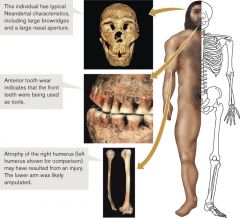
The wear pattern on the teeth of this Shanidar 1 Neandertal indicates
|
he used his teeth like a third hand.
|
|
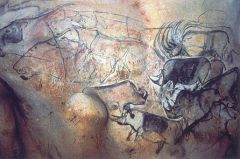
This cave wall in Chauvet, France, shows
|
that early modern Homo sapiens were creating art as early as 30,000 years ago
|
|
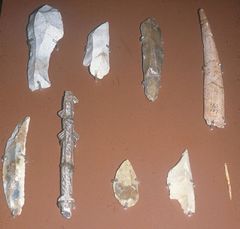
Which of these tools indicates that H. sapiens began eating a new type of food?
|
harpoon
|
|
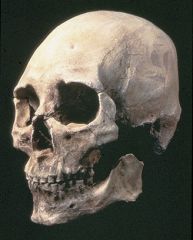
Some people think the reconstruction of Kennewick Man’s skull looks a bit like Patrick Stewart, the actor who played Captain Picard on Star Trek. The cranial morphology of Kennewick Man, however, shows
|
a robust face and jaws that are not found in modern European men. |
|
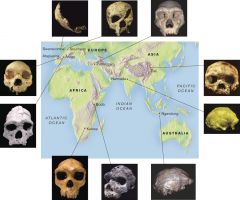
Based on this map of the location of important archaic Homo sapiens fossils, you could say that
|
All of these are correct
|

